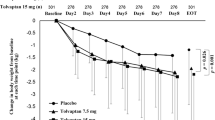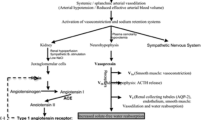Summary
The effects of torasemide (20 mg/day) and furosemide (50 mg/day), each given over 4 days, were compared in a randomized and crossover study carried out in seven patients with cirrhosis and tense ascites. Patients also received a low-sodium (40 mmol/day) diet and the aldosterone antagonist, potassium canrenoate (100 mg b.i.d.). Torasemide induced a remarkably higher natriuretic (120±15 vs. 33±6 mmol/day, p<0.02) and diuretic (1450±63 vs. 900±58 ml, p<0.005) effect than furosemide. Body weight loss was also significantly higher (2.5±1.6 vs. 0.2±1.3 kg, p<0.01) during the torasemide period. Kaliuresis was similar during the two treatment periods, despite the striking differences observed in natriuresis. Neither torasemide nor furosemide induced any significant change in serum electrolyte or creatinine concentrations, or in ammonia levels. The results of this study indicate that torasemide is suitable for the treatment of sodium retention in patients with cirrhosis and ascites.
Similar content being viewed by others
References
Epstein M. Renal sodium handling in cirrhosis.Semin Nephrol 1983;3:225–240.
Schrier RW, Arroyo V, Bernardi M, et al. Peripheral arterial vasodilation hypothesis: A proposal for the initiation of renal sodium and water retention in cirrhosis.Hepatology 1988;8:1151–1157.
Galambos JT.Cirrhosis. Philadelphia: WB Saunders, 1979.
Conn HO. The rational management of ascites.Prog Liver Dis 1972;4:269–288.
Arroyo V, Rimola A, Rodes J. Pathogenesis and treatment of ascites. In: Thomas HC, Jones EA, eds.Recent Advances in Hepatology, No. 2. Edinburgh: Churchill Livingstone, 1986:155–174.
Gentilini P, La Villa G, Laffi G, et al. Sodium retention in cirrhosis: Aspects of pathophysiology and treatment.Front Gastrointest Res 1986;9:203–218.
Campra JL, Reynolds TB. Effectiveness of high-dose spironolactone therapy in patients with chronic liver disease and relatively refractory ascites.Dig Dis Sci 1978;23:1025–1030.
Perez-Ayuso RM, Arroyo V, Planas R, et al. Randomized comparative study of efficacy of furosemide versus spironolactone in non-azotemic cirrhosis with ascites.Gastroenterology 1984;84:961–968.
Pinzani M, Daskalopoulos G, Laffi G, et al. Altered furosemide pharmacokinetics in chronic alcoholic liver disease with ascites contributes to diuretic resistance.Gastroenterology 1987;92:294–298.
Shear L, Ching S, Gabuzda GJ. Compartimentalization of ascites and edema in patients with hepatic cirrhosis.Gastroenterology 1970;282:1391–1396.
Arroyo V, Epstein M, Gallus G, et al. Refractory ascites in cirrhosis: Mechanism and treatment.Gastroenterology Int 1989;2:195–207.
Rodes J, Bosch J, Arroyo V. Clinical types and drug therapy of renal impairment in cirrhosis.Postgrad Med J 1975;27:49–55.
Sherlock S, Senewiratne B, Scott A, Walker JG. Complications of diuretic therapy in hepatic cirrhosis.Lancet 1966;1:1049–1053.
Gabow PA, Moore S, Schrier RW. Spironolactone induced hyperchloremic acidosis in cirrhosis.Ann Intern Med 1979;90:338–340.
Baertl JM, Sancetta SM, Gabuzda GJ. Relation of acute potassium depletion to renal ammonium metabolism in patients with cirrhosis.J Clin Invest 1963;42:696–707.
Brater DC, Leinfelder J, Anderson SA. Clinical pharmacology of torasemide, a new loop diuretic.Clin Pharmacol Ther 1987;42:187–192.
Lambe R, Kennedy O, Kenny M, et al. Study of the tolerance and diuretic properties of torasemide following oral or intravenous administration to healthy volunteers.Eur J Clin Pharmacol 1986;31(Suppl):9–14.
Reyes AJ, Leary WP, Byl van der K. Excretion of urinary fluid and solutes after single doses of furosemide and hydrochlorothiazide and of four different single doses of the diuretic torasemide in healthy subjects.Prog Pharmacol Clin Pharmacol 1990;8(1):47–71.
Broekhuysen J, Deger F, Douchamps J, et al. Torasemide, a new potent diuretic: Double-blind comparison with furosemide.Eur J Clin Pharmacol 1986;31(Suppl):29–34.
Neugebauer G, Basenfelder E, von Mollendorff E. Pharmacokinetics and metabolism of torasemide in man.Arzneim-Forsch 1988;38(I):164–166.
Lesne M. Comparison of pharmacokinetics and pharmacodynamics of torasemide and furosemide in healthy volunteers.Arzneim-Forsch 1988;38(I):160–163.
Scheen AJ, Vancrombreucq JC, Delarge J, et al. Diuretic activity of torasemide and furosemide in chronic heart failure: A comparative double-blind cross-over study.Eur J Clin Pharmacol 1986;31(Suppl):35–42.
Spannbrucker N, Achhammer I, Metz P, Glocke M. Comparative study of the antihypertensive efficacy of torasemide and indapamide in patients with essential hypertension.Arzneim-Forsch 1988;38(I):190–193.
Clasen W, Khartabil T, Imm S, Kindler J. Torasemide for diuretic treatment of advanced chronic renal failure.Arzneim-Forsch 1988;38(I):209–211.
Klütsch K, Großwendt J, Haecker W. Single dose comparison of torasemide and furosemide in patients with advanced renal failure.Arzneim-Forsch 1988;38(I):200–204.
Brater DC. Clinical pharmacokinetics. In: Eknoyan G, Martinez-Maldonado M, eds.The physiological basis of diuretic therapy in clinical medicine. Orlando: Grune & Stratton, 1986:27–55.
Sawhney VK, Gregory PB, Swezey SE, Blaschke TF. Furosemide disposition in cirrhotic patients.Gastroenterology 1981;81:1012–1016.
Villeneuve JP, Verbeeck RK, Wilkinson GR, Branch RA. Furosemide kinetics and dynamics in patients with cirrhosis.Clin Pharmacol Ther 1986;40:14–20.
Brunner G, von Bergmann K, Häcker W, von Möllendorff E. Comparison of diuretic effects and pharmacokinetics of torasemide and furosemide after a single oral dose in patients with hydropically decompensated cirrhosis of the liver.Arzneim-Forsch 1988;38(I):176–179
Frommer JP, Wesson DE, Eknoyan G. Side effects and complications of diuretic therapy. In: Eknoyan G, Martinez-Maldonado M, eds.The Physiological Basis of Diuretic Therapy in Clinical Medicine. Orlando: Grune & Stratton, 1986:293–309.
Perez GO, Oster JR. Altered potassium metabolism in liver disease. In: Epstein M, ed.The Kidney in Liver Disease, 2nd ed. New York: Elsevier Science, 1983:183–201.
Author information
Authors and Affiliations
Rights and permissions
About this article
Cite this article
Gentilini, P., Laffi, G., La Villa, G. et al. Torasemide in the treatment of patients with cirrhosis and ascites. Cardiovasc Drug Ther 7 (Suppl 1), 81–85 (1993). https://doi.org/10.1007/BF00877962
Issue Date:
DOI: https://doi.org/10.1007/BF00877962




